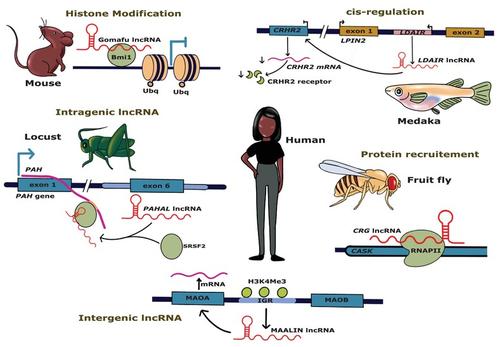Noncoding RNAs: Emerging regulators of behavioral complexity
引用次数: 0
Abstract
The mammalian genome encodes thousands of non−coding RNAs (ncRNAs), ranging in size from about 20 nucleotides (microRNAs or miRNAs) to kilobases (long non−coding RNAs or lncRNAs). ncRNAs contribute to a layer of gene regulation that could explain the evolution of massive phenotypic complexity even as the number of protein-coding genes remains unaltered. We propose that low conservation, poor expression, and highly restricted spatiotemporal expression patterns—conventionally considered ncRNAs may affect behavior through direct, rapid, and often sustained regulation of gene expression at the transcriptional, post-transcriptional, or translational levels. Besides these direct roles, their effect during neurodevelopment may manifest as behavioral changes later in the organism's life, especially when exposed to environmental cues like stress and seasonal changes. The lncRNAs affect behavior through diverse mechanisms like sponging of miRNAs, recruitment of chromatin modifiers, and regulation of alternative splicing. We highlight the need for synthesis between rigorously designed behavioral paradigms in model organisms and the wide diversity of behaviors documented by ethologists through field studies on organisms exquisitely adapted to their environmental niche. Comparative genomics and the latest advancements in transcriptomics provide an unprecedented scope for merging field and lab studies on model and non−model organisms to shed light on the role of ncRNAs in driving the behavioral responses of individuals and groups. We touch upon the technical challenges and contentious issues that must be resolved to fully understand the role of ncRNAs in regulating complex behavioral traits.

非编码 RNA:行为复杂性的新兴调节因子
哺乳动物基因组编码数千种非编码 RNA(ncRNA),大小从约 20 个核苷酸(microRNA 或 miRNA)到数千个碱基(长非编码 RNA 或 lncRNA)不等。ncRNA 是基因调控的一个层次,可以解释大规模表型复杂性的进化,即使蛋白质编码基因的数量保持不变。我们认为,传统意义上的 ncRNA 保存率低、表达能力差、时空表达模式高度受限,它们可能通过在转录、转录后或翻译水平上对基因表达进行直接、快速且通常持续的调控来影响行为。除了这些直接作用外,它们在神经发育过程中的影响还可能表现为生物体生命后期的行为变化,尤其是在暴露于压力和季节变化等环境线索时。lncRNA通过多种机制影响行为,如miRNA的海绵效应、染色质修饰因子的招募以及替代剪接的调控。我们强调,需要将模型生物中严格设计的行为范例与人种学家通过对极度适应其环境生态位的生物进行实地研究而记录的多种行为综合起来。比较基因组学和转录组学的最新进展为合并模式生物和非模式生物的野外和实验室研究提供了前所未有的空间,从而揭示 ncRNA 在驱动个体和群体行为反应中的作用。我们将探讨为充分了解 ncRNA 在调控复杂行为特征中的作用而必须解决的技术挑战和争议问题。
本文章由计算机程序翻译,如有差异,请以英文原文为准。
求助全文
约1分钟内获得全文
求助全文

 求助内容:
求助内容: 应助结果提醒方式:
应助结果提醒方式:


